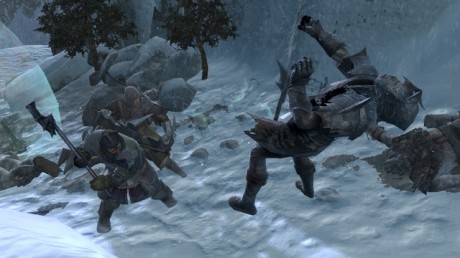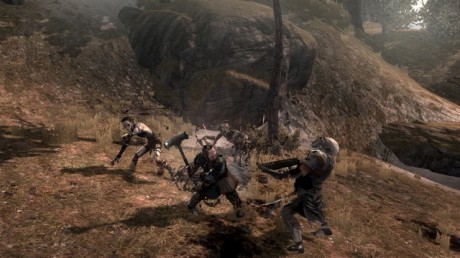Snowblind Studios explores the previously unseen northern battles of Middle-earth in this action role-playing game.




We’ve seen games individually based on the Lord of the Rings films and books, but we haven’t seen a game that encompassed nearly all major media birthed from Tolkien’s fantasy universe until now.
Warner Bros. and Snowblind Studios have license to use both the films and the books in their upcoming action role-playing game Lord of the Rings: War in the North. While this ostensibly lets the development team at Snowblind borrow visual elements from the films and stay closer to the lore of the books, their relationship with the fantasy universe created by Tolkien even goes deeper. The Tolkien estate is working in conjunction with the development team on the new story, overseeing details to ensure that it fits in within the rest of the Lord of the Rings canon.
War in the North occurs around the same time as the War of the Ring in which Frodo and Sam make their way to Mordor as the rest of Middle-earth fends off Sauron. And much like that story, War in the North focuses on the fellowship of a dunedain (ranger), dwarf, and elf attempting to fend off Sauron’s armies in the north headed by one of Sauron’s top lieutenants, Agandaur. Using this fellowship as the foundation for gameplay means that you’re never alone.
You always have direct control over one member of the fellowship whether you’re playing alone or with two other people. But if you are playing solo, then the AI will take over the other members. Additionally, if you’re playing as the dwarf but feel like switching to the ranger, you’ll have opportunities to switch at various hub areas.
The reason you might want to switch, and the reason why you’re always playing with two other characters at any given time, is that members of the team have their own strengths and skills that are designed to work more effectively when used in conjunction with each other. For example, Farin the dwarf is the tank of the group, which means he’s most effective when engaged in melee combat. In fact, one of his special abilities, called war cry, is even designed to draw enemies toward him and away from his teammates who might have a harder time standing toe-to-toe with more powerful foes.
This war cry skill also makes him impervious to knockdown strikes, but he can still take damage, and you would do well to use evasive moves while in this state. Meanwhile, Eradan the ranger is formidable at both close and long range, but he has the ability to surprise enemies with his special stealth skills. Finally, Andriel the elf can be used primarily as a support-ranged character because one of her skills lets her cast an orb that simultaneously heals other members of the fellowship and deflects enemy projectiles.
However, she can also dual-wield various weapons, which can make her effective in close combat.
The key to all of these abilities is to find a balance and recognize what tactics work in certain situations. For example, while Farin is best suited for melee, it doesn’t mean that his ranged attacks are completely worthless.
In fact, Snowblind wants you to think of his range attacks the same way you would think of a powerful weapon in a game like Resident Evil and its magnum handgun; you may not get a lot of ammunition, but the ammunition you do have is quite powerful when used properly. You’ll find similar characteristics for other members of the fellowship as well.

In terms of mechanics, ranged attacks are quite easy to execute, thanks to the third-person perspective, which lets War of the North use a control scheme not unlike those found in other shooters. This camera perspective also brings you closer into the game’s melee system, which often produces some rather violent results.
War in the North utilizes a combo system that ultimately tries to reward you for smoothly linking your attacks together. As you hack away at your enemy, a bar appears over the enemy’s head, indicating how close you are to executing a critical attack (performed by pressing a different button). If you do land a critical attack, your character will go into heroic mode, which gives bonuses on damage and experience. It’s worth mentioning that while in heroic mode, combat gets especially brutal–limbs and heads will go flying.
When you earn enough experience to level your character, you will be able to put points in various stats, such as strength (for melee damage), will (for power), dexterity (for range weapons), and stamina (for health). As you gain levels, you will also gain access to more abilities and skills, some of which involve weapon specializations.
Of course, leveling and messing around with stats isn’t the only way to customize your character. As with Snowblind’s previous action RPGs, War in the North relies heavily on loot as a means to enhance your character’s abilities, as well as provide some incentive for light exploration within the game’s environments. When the fellowship happens upon a treasure chest, members get their own set of loot that they can also trade with other characters (or players).
To get the really good loot, you’ll have to make use of some other special skills the fellowship has, but the catch is that they only function in multiplayer with other human players. Farin has the ability to see weaknesses in walls and can smash through them to find hidden loot. Eradan can see tracks in the wilderness that lead to new areas, while Andriel can spot special herbs, harvest them, and then give them to other players.
These mechanics represent much of what War in the North is about and how the development team encourages you to play with other people as often as possible.

What’s interesting is that when you are playing with other people, the characters you bring are still your own. When playing in single-player, you’re still collectively leveling up and gearing your entire fellowship–not just one character, even though you have direct control over one at any given time. Additionally, Snowblind is giving numerous options for multiplayer, including two-player local split-screen with one online player, two to three player LAN, split-screen with just two players, and, of course, three players online. It’s worth mentioning that the fellowship is always Farin, Eradan, and Andriel, so you won’t have a team of three elves, two dwarves and a ranger, or any other such combination.
Snowblind is trying to weave an intricate story within the Lord of the Rings universe, and granting the ability to customize your fellowship would alter the narrative aspects of the game dramatically.
We only got a brief taste of the game as the three were dropped off on the Misty Mountains by the eagles where the ground encountered a small sampling of the 40 or so enemy types that are a part of War in the North. We’re interested to see more interaction between the various character abilities play out and more of the story unfold before the game is released on the PlayStation 3, PC, and Xbox 360 later this year.